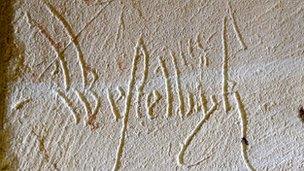Medieval graffiti sheds light on Norfolk churches
- Published

The cog was an oak vessel used in seagoing trade in medieval Europe
Research into Norfolk's medieval churches has discovered that many are covered in graffiti more than 500 years old.
The Norfolk Medieval Graffiti Survey (NMGS) was set up in 2010 with the aim of identifying and recording pre-Reformation graffiti inscriptions.
Project director Matt Champion believes the two-year survey will change the thinking about how the inside of a medieval church would have looked in the middle ages.
It could also shed light on the history of a church.
One of the first sites to be examined by the NMGS was Binham Priory in North Norfolk.
The Priory is famous for its revolutionary window construction technique which allowed light to flood into the previously dark interiors of the medieval church.
But the west window was bricked up in the 18th Century, and, with no authentic pictures surviving, its design has been the subject of debate.
During the survey of the building, NMGS members found a series of architectural designs etched onto a wall in the church, which are believed to relate to the "lost" west window.
Mr Champion says he believes the master mason used the wall for his drawings instead of paper.
During the Middle Ages churches would have been places of vibrant colour and paintwork, with lower sections of the wall coloured with a single pigment.
Amongst the graffiti found in In St Margaret's Church, Cley, the NMGS found a drawing of a sailing ship.
"It's a design typical of a North Sea cog [an oak vessel associated with seagoing trade in medieval Europe] of the late 14th Century," said Mr Champion.

Graffiti would have been scratched through pigment on the walls and pillars
"In the Middle Ages the pillars at Cley would have been black and the graffiti scratched through the pigment.
"The reason the graffiti hasn't been found before is because we haven't been looking for it," he added.
He said that similar ships had been found at other coastal churches in the county.
"What we think is happening here is that they are either prayers of thanksgiving for voyages undertaken or they're really asking for a safe journey yet to come.
"Today graffiti is seen as something that's very destructive, but that simply wasn't the case back then.
"This was both an accepted and acceptable part of everyday worship."
Thanks to the success of the NMGS, the idea of checking other churches for such graffiti has now spread to six other counties, including Suffolk and Bedfordshire.
More on this story on BBC Inside Out East at 19:30 GMT on Monday 7 January